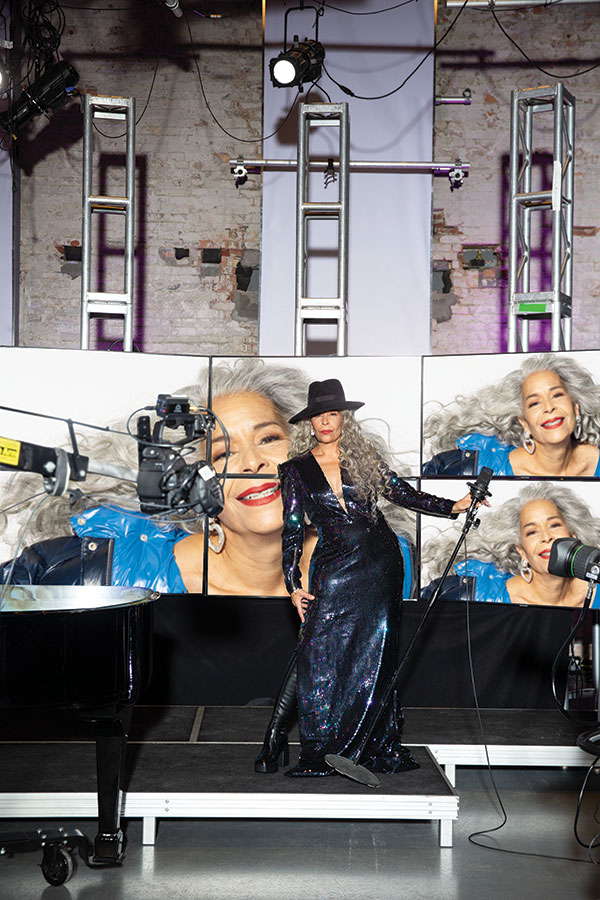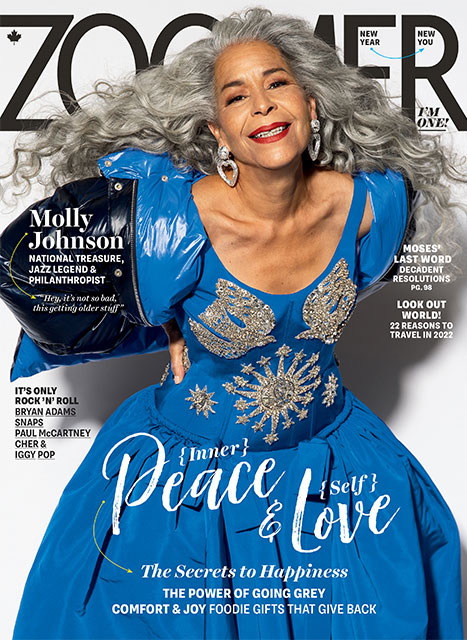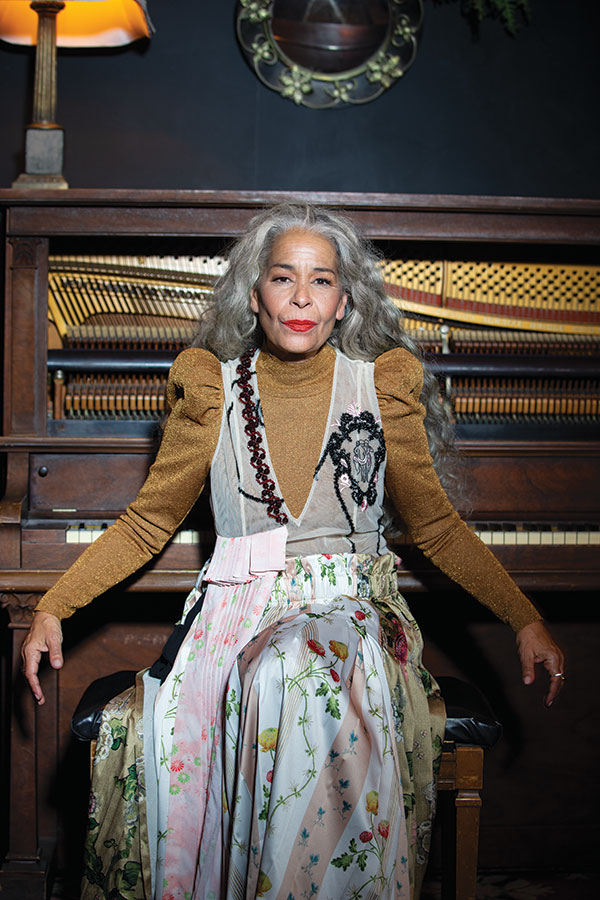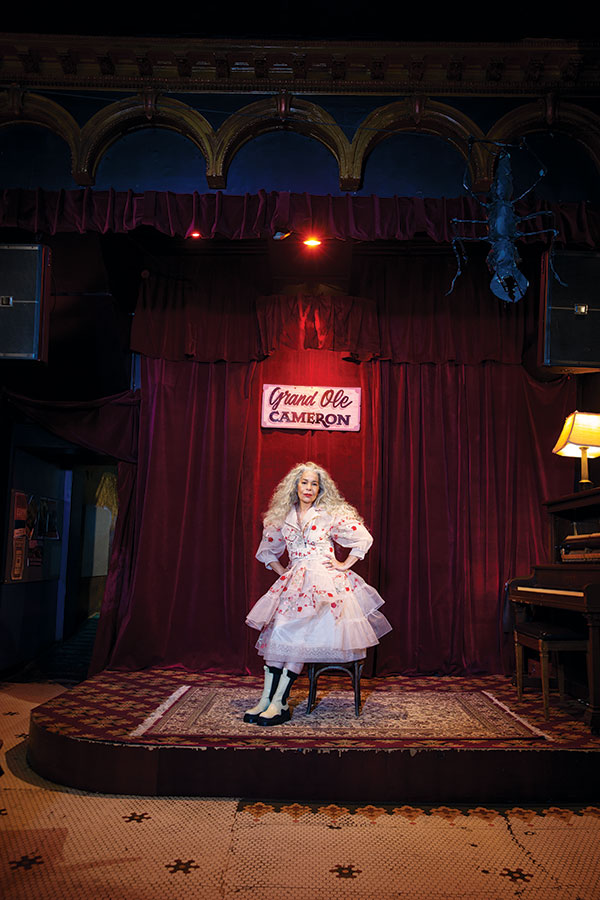Canadian Singer Molly Johnson on Meeting Princess Diana, Her Latest Album and Her Funky Musical Roots

Toronto jazz singer Molly Johnson regales us with stories about Princess Diana, her career and her new album. Photo: Gabor Jurina
By any reasonable measure Molly Johnson should be an egotistical jerk surrounded by a squad of flesh-eating publicists determined to thwart personal questions and keep the focus squarely on the newest thing she is promoting. But the singer-songwriter’s publicist is nowhere to be seen on a recent Zoom call, where Johnson sits alone at the dining room table in her older brother Clark Johnson’s house on a rainy Monday in Toronto, candidly dishing on everyone from former journalist and governor general Adrienne Clarkson to one-time Maple Leafs captain Doug Gilmour to the late Diana, Princess of Wales. Because she can, and because that’s how she rolls.
Funny, unfiltered, charming and with a bazillion jaw-dropping stories socked away in her memory bank, Johnson is the kind of person you pray is in the next seat on a long-haul flight. Today, she is talking about the day she met Diana on a 1991 visit to the Toronto AIDS hospice, Casey House, and performing for the Prince and Princess of Wales on the Royal Yacht Britannia a few years later.
“I ended up singing, while [playwright] Tomson Highway played piano. I mean, c’mon! They had this English-style pub downstairs, and we all ended up singing stupid pub songs. She was luminous. I can’t watch any Diana stuff because I knew her. I got to sit and talk with her about AIDS and AIDS research. She didn’t get to watch her boys grow up.”

Johnson, 62, the one-time queen of Queen Street West when Queen West was shorthand for super cool, is a triple threat (singer, actor, former CBC radio host) who, after decades in the limelight, knows how to calibrate the tenor of the moment.
“Molly is the most natural musician I can think of,” says renowned bassist Mike Downes, who has appeared on eight of nine Johnson solo albums dating back to 2000, including 2009’s Lucky, which scored a Juno Award for Vocal Jazz Album of the Year.
“She channels something spectacular,” says Downes, who has toured with her ever since. “It never ceases to amaze me how present she is on stage, just such a communicator when engaging with the audience.”
Before she was 10, she gathered raves as an actor in productions for Toronto theatre impresario Ed Mirvish, her mother’s acquaintance. She studied at the National Ballet School. She has sung for Nelson Mandela, Quincy Jones and a sizeable chunk of North America and France as a punk, rocker and jazz belter. She is also a bandleader, songwriter, festival organizer and wildly successful altruist, who takes after her mother, the late Suzanne Johnson, co-founder of the Canadian international development organization Cuso International and the feminist fundraising group MATCH International Centre (now The Equality Fund).
One of Molly Johnson’s crowning achievements was the Kumbaya Foundation, which staged the annual Kumbaya Festival concerts from 1993 to 1996, and raised a cool million-odd dollars for people living with HIV/AIDS. They were broadcast, Live Aid-style, on MuchMusic by Moses Znaimer, the founder and CEO of ZoomerMedia, whom Johnson has known for decades, since back in Toronto’s booze can days.
“I was doing my punk funk rock thing and Moses suggested a bit of jazz,” she says. “And the rest is history.”

The cream of Canadian music, comedy, sports and media eagerly queued up to perform for Kumbaya. Later, when the Stephen Lewis Foundation launched in 2003 to assist grassroots HIV/AIDS-related projects in Africa, Johnson hosted, performed and spoke at various events, including the first Grandmothers Gathering on the eve of the International AIDS Conference in Toronto in 2006, and later joined its Arts Fund Advisory Committee in 2011.
“She’s a kindred spirit and supporter since our inception,” says Ilana Landsberg-Lewis, the former executive director and co-founder, with her father, of the Stephen Lewis Foundation. She waxes fondly about Johnson, who brought “her deep personal commitment to the struggle to subdue the AIDS pandemic.”
Of course, since Johnson is tireless, there is something new to promote: her latest album, the alternately subdued and swinging seasonal entry It’s A Snow Globe World, which will see Johnson and her ace band — Downes, drummer Davide DiRenzo and pianist Robi Botos — play marquee venues in Ontario and Quebec in December.
The new album and tour come at what might be the most interesting moment of Johnson’s entire career: the chapter she is writing after watching her boys — Otis, 25, and Henry, 22 — become adults. “It’s been such a joy to grow my sons into real gentlemen. It’s my greatest achievement and it’s worth every job I said no to when they were growing up,” she says. “But if I had just been starting out when I had my kids, it would have been a different story. Women are saddled with this, ‘We have to have it all’ mentality in a way men certainly aren’t. What is ‘all’ anyways?”

Older brother Clark — an actor and director whose credits include the acclaimed mid-’90s cop drama Homicide: Life on the Street and early aughts drama, The Wire — says in a phone interview from New York, where he lives part time, that being a great mom was always the most important thing to his sister. “Molly timed her tours such that she could raise her kids. Now that they’re young adults, she’s at that stage where she is saying, ‘Now what do I do?’”
Johnson is unlikely to be stumped by that question. She is at the point where there is nothing left to prove. She may not be a perfectionist, exactly, but you can bet she cares deeply about her legacy, especially as she navigates life as an empty nester. “Nothing says, ‘Molly get your s–t together’ like preparing for a show at Massey Hall,” she howls. Johnson plays the venerable Toronto music venue in December, just weeks after it reopened following a three-year renovation. “Are the spirits still there at Massey Hall?” she wonders. “There’s some kind of energy to that old building. Come Dec. 17, we’ll see.”
To prepare for the 90-minute show, Johnson has been working out twice a day. “It’s A Snow Globe World is a very muscular record,” she says. “I’m not leaning up against a piano whispering into a mic. That’s not this record. There are days I wish it was, but it’s not.” As for ageism in the music business, she is trying hard to ignore it. “I’m just keeping moving, being as strong and smart as I can be, and hoping younger women see me and say, ‘Hey, it’s not so bad, this getting older stuff.’”

The album doesn’t fit the conventional mould, volleying between upbeat orchestral pop corkers like the lead single, “Don’t You Know It’s Christmas” and candlelit ballads like “Maybe This Year.” But please don’t call it a Christmas record, even if its 10 songs — including some fabulously angular covers, like mid-century jazz singer June Christy’s buoyant “Winter’s Got Spring Up its Sleeve” and the slightly melancholic “What Are You Doing New Year’s Eve,” made famous by Ella Fitzgerald — are firmly rooted in deepest, darkest December.
“We’re in Canada. Not everybody here believes in the baby Jesus,” says Johnson, who speaks in exclamation points. “I wanted to make a holiday record filled with light and joy and family and being together … all those clichéd things. In every faith, those things are celebrated at this time of year.”
The Johnson siblings consistently cite their parents’ ethics as the foundation of their lives, and it’s clear Suzanne’s compassion manifested deeply in Molly. “That definitely came from growing up under my mom’s kitchen table,” she says. “I believe incredible things can happen when a group of women gather around a kitchen table.”
Suzanne was born into an “affluent” white family in 1932. Johnson says she was “excommunicated” when she started dating her father, John Johnson, a Black former pro-football player for the Philadelphia Eagles. They met in Switzerland in 1947, when Suzanne was at finishing school and John, 27, was a GI returning from the Second World War. (“She might have been 16 when they met; the records are unclear. But she was very young,” Johnson confirms.)
The couple married in New York City in 1950, moved to Canada in 1958 and eventually settled in Toronto, where John was an athletics professor at Ryerson University. Molly and Clark have two sibs, Taborah, who is a singer, actor and voice actor, and Ron, a retired social worker. “The very nature of my father being Black and married to a white woman in the United States in the 1950s was a civil rights moment,” Johnson says. “My father could have been lynched in some states. So yes, moving to Canada was the right thing to do.”
Clark says the Johnson children would traipse off to wherever their mother was working, in places like Cuba or Mexico. “The big non-profits are good at dropping off skids of food to feed flood victims,” he says. “But my mom’s thing was always, ‘Ask the people what they need.’ She would go to communities and be involved with what they were doing. She definitely impressed upon us the importance of giving back, and Molly really followed up on that.”
Long before HIV/AIDS was identified in the United States and Canada, Suzanne came back from Africa talking about “the slimming disease,” Johnson recalls, explaining why HIV/AIDS became her charitable focus. “Then it hit the gay community. I had friends who died of AIDS. [Toronto designer and visual artist] Tim Jocelyn died of AIDS in 1986 when there was still so much uncertainty and misinformation about it.
“At that point I was thinking of quitting music but needed something else. So, I took my Rolodex — there’s an old-fashioned word for you — where I had stored every name in the Canadian music industry and decided to use it for good by launching what became Kumbaya.” To make it happen, she leaned on her relationships with activist, journalist and Casey House co-founder June Callwood and then-mayor Barbara Hall, as well as her mother.
By then, Johnson was “already legendary” on the Toronto music scene, according to Blue Rodeo lynchpin and fellow Queen Street alum, Jim Cuddy. Her initial rise was inextricably tied to the also legendary dive bar and performance space, The Cameron House, which, throughout the ’80s and beyond, nurtured talents like Johnson, Blue Rodeo, Ron Sexsmith and Holly Cole, and offered Queen West scenesters, scribes and hangers-on cheap drinks and easy access to wildly inventive entertainment.

Throughout much of the ’80s, Johnson fronted funk-rock combo Alta Moda with song writing partner and guitarist Norman Orenstein, and they were frequently booked as an opening act for an eclectic roster of alt-rock bands by local promoters Gary Cormier and Gary Topp (known as the Garys). Alta Moda also popped up at local booze cans, which was de rigueur for emerging bands then, as now. Despite the exposure, the band’s one album, released in 1987, failed to ignite. And Alta Moda — which both Johnson and Orenstein agree would have flourished if social media had been available to capitalize on the innovative visual aspects that earmarked their live shows — dissolved.
Johnson and Orenstein regrouped as Infidels, but again, mainstream success eluded them. “We got amazing reviews when our debut album came out [in 1991],” she says. Infidels recorded a sophomore album, but it was never released. “That was a culmination of many reasons; human dynamics, business, legal … it just didn’t come together,” Orenstein says during a phone interview from Toronto, adding that Johnson has “amazing texture to her voice and obviously great ears. That unreleased album wasn’t a failure. That’s just the music business.”
Johnson sees it differently. “What really killed the Infidels was people not being ready for a brown-skinned girl singing like Aerosmith. They wanted me to sing something more colour appropriate. Here was this mixed-race band – Norman is Jewish and Japanese, I’m Black and white — playing funky rock ’n’ roll. Nobody wanted to hear that from us at that time. They wanted to hear me sing, ‘Oh baby give it to me.’”
The racism has come “from both sides — never white enough, never Black enough,” says Johnson. “I never got real traction in the music business until I started singing jazz, which was seemingly a more appropriate genre for a brown-skinned girl. That still pisses me off. But song writing keeps me sane.”
The Cameron House, where Johnson rented an apartment above the bar for a decade and cleaned toilets to top up her coffers, sowed the seeds for her longest-lasting and most successful manifestation as a jazz singer. She hosted Blue Mondays with bassist David Piltch and drummer Aaron Davis, where they explored the Great American Songbook long before it was fashionable, and she developed her gloriously inimitable voice.
“At that time, I was morphing from Alta Moda to Infidels. I don’t play an instrument, yet I oversaw melody and lyrics. I really believed if I sat down with Gershwin and Ellington and Billy Strayhorn and these amazing jazz players and learned their stuff, I’d get it. I wanted to learn how people construct melody,” Johnson says. “So, at the Cameron, I sat on the stage with Dave and Aaron and this big book of standards, and we’d literally flip through it trying to figure out these songs … in front of an audience. That I charged money to be there! I hadn’t really lived enough at that point to sing those songs, even though it was the music I looked like I should be singing.”
With a chuckle, Cuddy recounts an “apocryphal rumour,” which Molly “half-denies,” about how people would come to the Cameron for her early set at 7 p.m. and, by 8 p.m., there would still be no sign of the singer. “Allegedly, Molly, upstairs in her apartment, would look through a crack in the floor and wait until the room was full before donning her beautiful dress and coming down,” says Cuddy, who played Kumbaya in the 1990s and, more recently, was a guest at the 2019 edition of the Kensington Market Jazz Festival, which Johnson launched in 2016. “True or not,” Cuddy says, “it’s a great story.”
While Johnson was a key part of various hit singles — singing backup vocals on Breeding Ground’s “Happy Now I Know” in 1986 and Tom Cochrane’s “Life Is a Highway” in the early ’90s — she has never scored a smash of her own, despite a critically praised solo discography dating back 20 years. She is also, curiously, seldom fêted as a songwriter, something long-time collaborator Steve MacKinnon attributes to the magnificence of her “sandpapery, dark but playful singing voice, which overshadows everything else.”
The Toronto composer and producer, whose extensive credits include working with Olivia Newton-John, Marc Jordan and Serena Ryder, has worked with Johnson on every solo album she has made, beginning with her self-titled debut in 2000. Indeed, her official entrée into a solo jazz career can be traced to MacKinnon, when, in the mid-’90s, he was a partner in a commercial music company hired to create a jingle for a U.S. campaign for Fruit of the Loom. He got the idea for Johnson to sing “a 1930s-style Django Reinhardt/Stéphane Grappelli track for the campaign.”
“From that 60-second clip we developed this song called ‘Long Wave Goodbye,’ which appears on her debut. We managed to get [French jazz violinist] Stéphane Grappelli [to play] on that track while he was touring; it was one of the last recordings he ever did. Molly and I have worked together since then.”
The addition of Grappelli, considered the “grandfather” of jazz violin, helped popularize her debut album in France, where she has a sizeable following. That success was buttressed, adds bassist Downes, by the song “Melody” off 2002’s Another Day, which “seemed to really connect with audiences there.”
After Johnson was named an Officer of the Order of Canada in 2008, which acknowledged her contribution to Canadian music as well as her work with the Kumbaya Foundation, her brother Clark says the family teasingly started calling her “Sir Molly.” Johnson remembers it as an “awesome” day. “It is the highest order a civilian can get from her people and her government. June Callwood made sure I got that because she was dying, and she wanted me to get that so I could keep going,” Johnson says, her voice breaking and tears gathering. “She knew it would open doors.” She is quiet for a moment. And then, in a snap, sad Molly is gone and boisterous Molly is back, cursing, giggling and hollering.
“At the Order of Canada ceremony, I got to have dinner with [former prime minister] Jean Chrétien. The f–king guy just sat down at my table. Oh my god! That guy is fun! We’ve been friends ever since. It was also pretty great being awarded the Queen Elizabeth II’s Diamond Jubilee Medal,” which happened in 2012.
In addition to all of that, Johnson is also, undeniably, a Toronto icon. “We have such a beautiful community of music and arts and culture here. I mean, I had Tom Wilson and Jim Cuddy at my jazz festival in 2019. I love the smallness of it all. It’s why I never left,” she says. “This is home.”
A version of this article appeared in the Dec. 2021/Jan. 2022 issue with the headline “All That Jazz,” p. 40.
RELATED:
Behind the Scenes With Canadian Jazz Legend Molly Johnson at Her Zoomer Cover Shoot
Molly Johnson on James Baldwin, Toni Morrison and Candacy Taylor